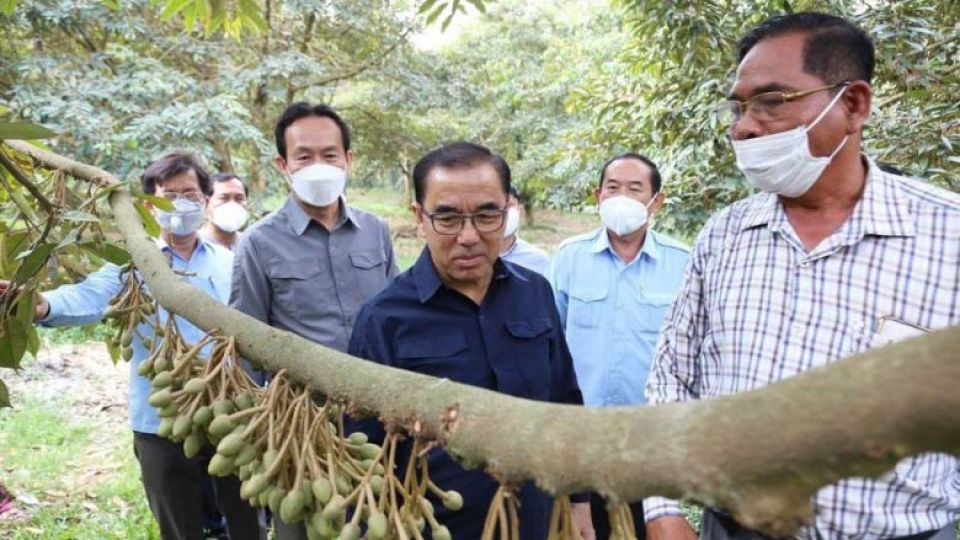February 3, 2022
PHNOM PENH – The Ministry of Agriculture is set to conduct a study on the phytosanitary requirements to export durian to China in the near future.
After bananas and then mangoes, longan is set to be the third fresh Cambodian fruit to be officially exported directly to the Chinese market, and a list of other agricultural products – including durians – are expected to follow in the years to come.
But to the dismay of agriculture sector players, Chinese authorities only consider a single product per country at a time to import, in a process that requires phytosanitary and other inspections.
Although durian is a strong contender for the fourth spot on the list, it is not yet clear if the government will push the pungent, spiky fruit through the process after longan.
Minister of Agriculture, Forestry and Fisheries Veng Sakhon on January 29 conducted a field visit to a durian farm in Krasaing village, Teuk Chrov commune, Dambe district, Tbong Khmum province.
Speaking at the orchard, Sakhon instructed the General Directorate of Agriculture to get in touch with Chinese customs to research the technical and legal document, procedural and phytosanitary requirements related to the direct shipment of Cambodian durians to China.
“We should work with mango exporters and yellow banana distributors to gain more insight into the possibility of exporting Cambodian durian to the Chinese market in the near future.
“Additionally, the General Directorate of Agriculture needs to update data on durian cultivation areas and yields throughout the country, and keep tabs – for research purposes – on techniques for cultivation, disease- and pest-control, and processing that comply with Cambodia Good Agricultural Practices [CamGAP], especially standards concerning export markets,” he said.
The minister spotlighted durian as a crop with high economic potential that requires sophisticated care to maximise production – from planting to pruning and disease- and pest-control – contingent on the number of fruits per tree and age, as well as soil management practices such as fertilising and watering.
Fresh durian was China’s highest-imported fruit in 2020, accounting for 22.4 per cent of the country’s total fruit imports, Mallika Boonmeetrakool Mahasook, an adviser to the Thai commerce minister said, according to The Nation.
China imported 0.575 million tonnes worth $2.3 billion that year, representing a 44 per cent rise over 2019, he said.
Sok Leng, the owner of the Sok Leng-Phanny orchard which was visited by the minister, told The Post on January 30 that the 13ha of his durian lands that are harvested yielded 100 tonnes of fruit last year, and would likely produce more in 2022.
He said his fruits sell very well in the area as well as in the capital, at a rate of 20,000 riel ($5) per kg. Leng advocated for an increased presence of Cambodian durian on the international stage, especially the Chinese market.
“After the agriculture minister inspected the durian orchard, the Tbong Khmum provincial Department of Agriculture discussed setting up a production cluster or durian cooperative in Tbong Khmum, to obtain precise information apropos conceivable cultivated and harvested areas and production volume, to supply both domestic and foreign markets,” Leng said.
However, he stressed that durian cultivation demands a lot of capital and that maintenance is quite challenging, requiring patience and technique to achieve optimal results.
Chan Sitha, a durian grower in Kampot province, said he and other farmers in the coastal locality are happy to work with the relevant ministries to study the feasibility and techniques of growing durian in line with Chinese standards.
“Durian had traditionally been cultivated through the techniques of the respective farmers, so any training on sanitary and phytosanitary standards led by experts from relevant ministries would provide support for Cambodian durians and enhance their exportability,” he said.
The total land under durian cultivation in Tbong Khmum’s top producers of Memot, Ponhea Kraek, Dambe and O’Reang-ou districts is 610ha, of which 300ha are harvested, with an average annual yield of 4,548 tonnes, the provincial agriculture department reported.
No figures were available for Suong town or the districts of Tbong Khmum or Kroch Chhmar, which are located in the northwestern part of the province.


